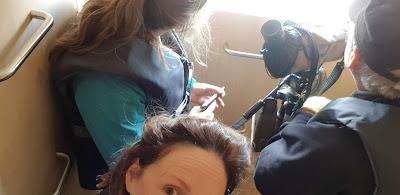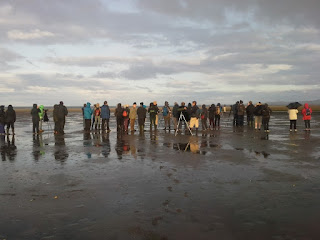Over the summer months we’ve been
receiving reports of how our feathered friends are faring at far-flung breeding
grounds. So, for this blog we’re going to open the files and take a look at how
two of the Dublin Bay-ringed Oystercatchers, or ‘Tjaldar’ in
Icelandic, got on over the last few months.
 |
| Oystercatcher on breeding territory, Scotland Photo by Thomas McDonnell |
Gudmundur Orn Benediktsson or Bói,
is helping the University of Iceland with a colour-ringing project they have
been running for several years. In the process, he has collected a fabulous
amount of data on colour-ringed waders in Iceland, one of which - luckily for
us - is the Oystercatcher ‘XT’.
 |
| Oystercatcher 'XT' on breeding territory at Leirhofn, Iceland 2018 Photo by Gudmundur Orn Benediktsson |
XT was colour ringed by the
Dublin Bay Birds Project (DBBP) in 2014 at Sandymount Strand in Dublin Bay. In
April 2015, the first ever resighting of this bird was made by Bói in Leirhöfn,
Iceland, 1,550 km from Sandymount Strand as the Oik flies. Since then, Bói sees
XT in Iceland every summer, with us seeing XT back in Dublin Bay each winter. Already this bird has been spotted at Sandymount after an
impressive return migration from Iceland (August 2019).
 |
The journey to and from Leirhöfn,
Iceland each year if XT takes the most direct route. A distance of 1,550 km
each way.
|
XT is an early bird, being one of
the first of the Oystercatchers to arrive on the breeding grounds in Leirhöfn
each year since Bói has been following its progress. This year, Boi first
observed it on March 10th which is the earliest observation he has had of it to
date on that breeding territory. Leaving Ireland’s more temperate climate this
early in the season is an ecological gamble.
On the one hand, as one of the
first Oystercatchers to arrive XT faces less competition for suitable breeding
habitat and can begin to breed earlier. This gives its offspring more time to
gain weight and condition prior to migration back to wintering grounds, which
increases their chances of survival on the arduous journey (Gill et al, 2013).
 |
| XT's nest at Leirhofn, Iceland 2018 Photo by Gudmundur Orn Benediktsson |
On the flip side, during the
first two weeks of March in 2019, daytime temperatures in northern Iceland
ranged from -5°C to 4°C during the day, and -15°C to 0°C at night (Accuweather
historical data). Surviving these freezing temperatures, particularly following
a trans-Atlantic migration when the need to feed is of critical importance for
these birds, is energetically very costly. Despite these tough conditions, we were
delighted to hear from Bói that XT and its unringed mate managed to produce
young this year, showing the resilience of these feathered fowl!
 |
| Oystercatcher with leggy chick! Photo by John Haslam |
Closer to home, John Bowler the RSPB Scotland Island Officer
for Tiree, has been keeping us up to date on how ‘ZN’, another Dublin Bay
colour-ringed Oystercatcher, has been faring.
 |
| Oystercatcher 'ZN' on breeding territory at Loch a’
Phuill, Isle of Tiree, Scotland Photo by John Bowler |
ZN found love with the Welsh-ringed bird ‘AY5’ in April this
year. AY5 was ringed at Bangor Harbour in Gwynedd, Wales, in January 2014 by
Stephen Dodd of the RSPB (who, incidentally, has submitted observations of some
of our other colour-ringed terns to us!). These two birds flew a combined 760
kilometres one way in order to raise the next generation!
 |
| Oystercatcher and Sanderling flock Photo by Kevin Murphy |
Ring-reading gives us a fantastic
insight into migration. It tells us when birds are beginning to migrate,
changes in timing of migration, areas which are important to these species both
as final destinations and pit stops, longevity and survival rates. So, a
massive thank you to Gudmundur and John and Stephen, and everyone else who
has read colour-rings, and sent them in to us! Ye’re a fabulous bunch!
 |
| Ring reading waders on Sandymount Strand in Dublin Bay |
If you spot an Oystercatcher,
Bar–tailed Godwit or Redshank colour-ringed by the Dublin Bay Birds Project you
can submit your resighting here. They really are appreciated! The DBBP colour-ring
combinations are shown below. Birds colour-ringed at North Bull Island have a
blue colour-ring with no inscription on the left leg rather than a yellow one.
 |
| Dublin Bay Birds Project colour ring combination for wading birds ringed on south Dublin Bay Photo by Richard Nairn |
 |
| Dublin Bay Birds Project colour ring combination for wading birds ringed on north Dublin Bay Photo by John Fox |
From all in the Dublin Bay Birds Project team, thanks so
much!!
Gill, J.A., Alves, J.A., Sutherland, W.J., Appleton, G.F,
Potts, P.M., and Gunnarsson, T.G. 2013. Why is timing of bird migration
advancing when individuals are not. Proceedings of the Royal Society for
Birds.






























